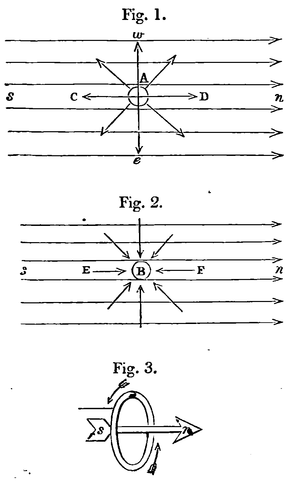where is the intensity of the magnetic force, and is the amount of magnetic matter pointing north in unit of volume.
The physical interpretation of this term is, that the force urging a north pole in the positive direction of is the product of the intensity of the magnetic force resolved in that direction, and the strength of the north pole of the magnet.
Let the parallel lines from left to right in fig. 1 represent a field of magnetic force such as that of the earth, being the direction from south to north. The vortices, according to our hypothesis, will be in the direction shown by the arrows in fig. 3, that is, in a plane perpendicular to the lines of force, and revolving in the direction of the hands of a watch when observed from looking towards . The parts of the vortices above the plane of the paper will be moving towards , and the parts below that plane towards .
We shall always mark by an arrow-head the direction in which we must look in order to see the vortices rotating in the direction of the hands of a watch. The arrow-head will then indicate the northward direction in the magnetic field, that is, the direction in which that end of a magnet which points to the north would set itself in the field.

Now let A be the end of a magnet which points north. Since it repels the north ends of other magnets, the lines of force will be directed from A outwards in all directions. On the north side the line AD will be in the same direction with the lines of the magnetic field, and the velocity of the vortices will he increased. On the south side the line AC will be in the opposite direction, and the velocity of the vortices will be diminished, so that the lines of force are more powerful on the north side of A than on the south side.
We have seen that the mechanical effect of the vortices is to produce a tension along their axes, so that the resultant effect








